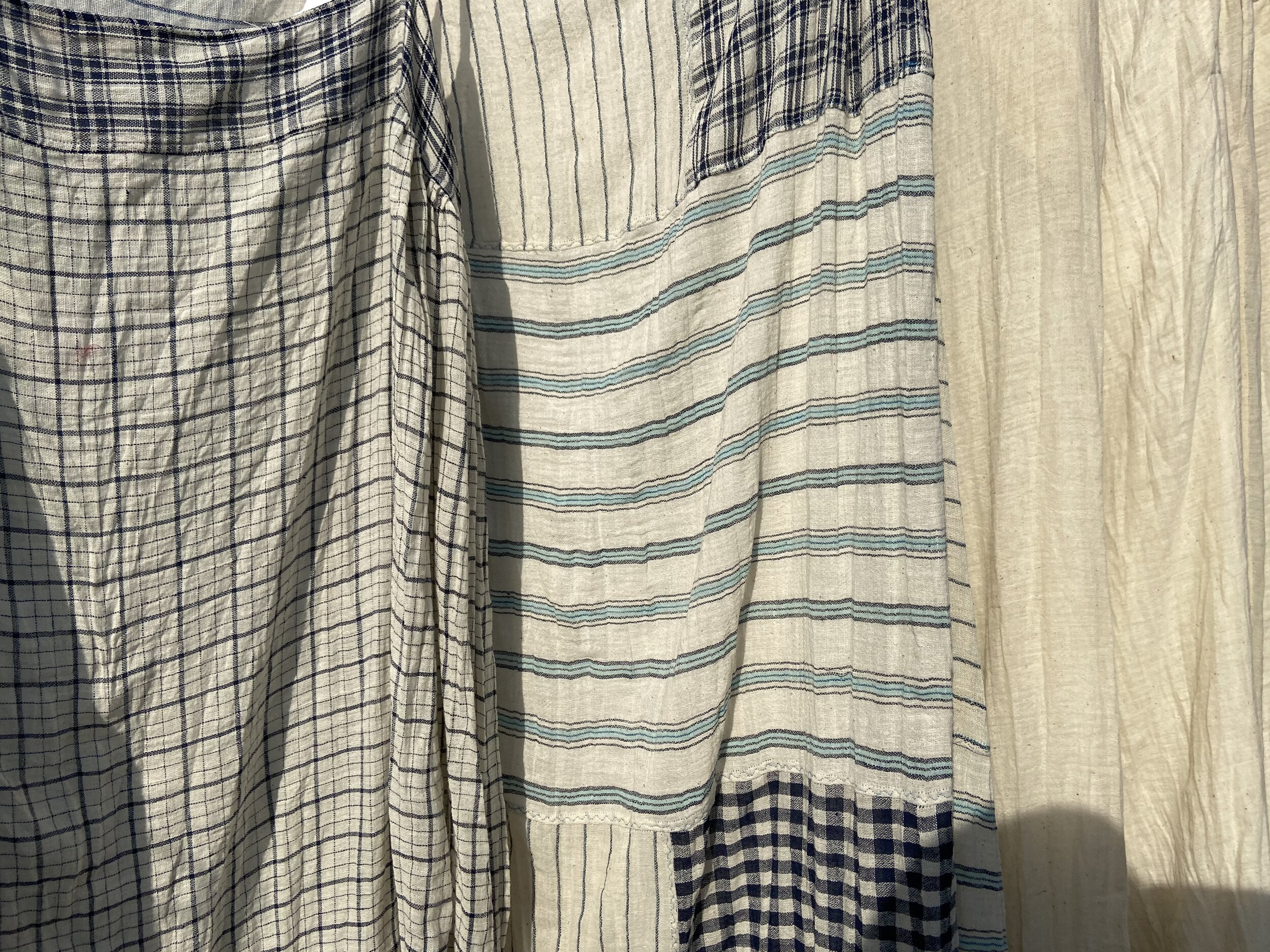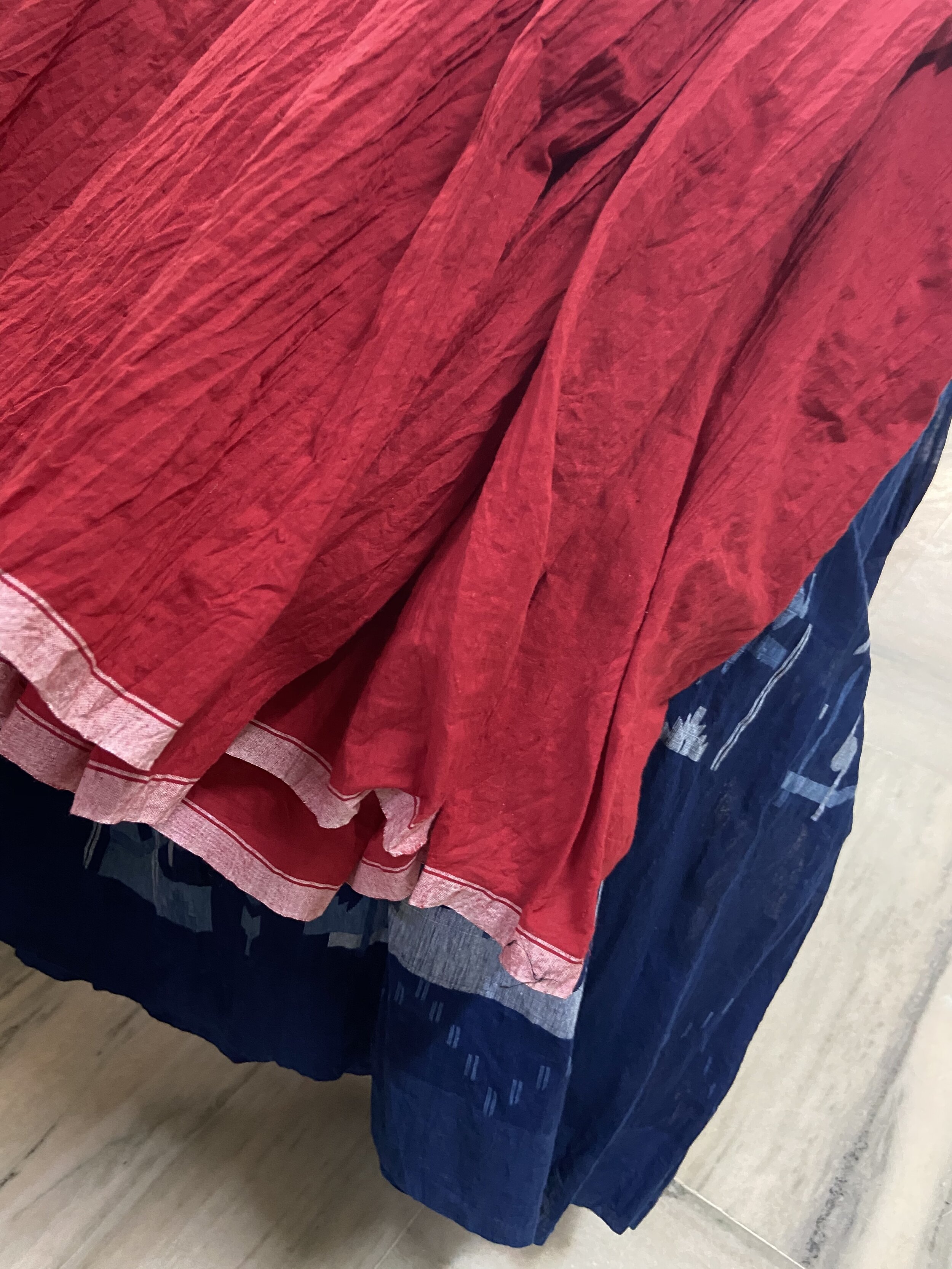Injiri Studio Visit
Chinar Farooqui founded Injiri in 2009. She is a textile and clothing designer in Jaipur. Her early encounters during her design education with traditional textiles and the indigenous creators of those crafts moulded her passion for handmade and artisanal work. Injiri as a brand focuses on weaving stories and garments sustainably and thoughtfully. Their clothing collection for women and textiles for home celebrates the beauty of slow processes of production and preserve the traditional techniques and richness of textile aesthetics. We visited her studio in Jaipur to chat with her about her process and vision for Indian contemporary clothing.
“I just believe there are so many classic designs that are so beautiful; it is difficult to do a lot of design work in sarees, other than colours or proportions.”
Products and Process
S: So what are the core textiles and techniques you work with.
C: The textiles are woven in one of the oldest centres of West Bengal. As you know it is one of the most important hubs for textiles. There we do all our fine muslins and jamdanis. We have been working with a set of weavers since the last six years. Initially, we had many people but then we shifted our concentration to one weaver family and we have been with them ever since. Apart from Jamdani there is Bhujodi, in kala cotton and wool, the latter for all our winter textiles. And recently, we started working in Srinagar ( for pashmina) and Lucknow for the last four years. We do a lot of chikankari, but not in terms of number of designs. We also do a bit of work in Maheshwar but not too much.
S: In terms of your actual clothing pieces, are they mostly separates? Would you say that to be your key style?
C: It is really difficult to do sets, I don’t know how people function with sets!
S: So, how come you have never ventured into making sarees?
C: I have done a line in sarees, but it is not exciting for me. I just believe there are so many classic designs that are so beautiful; it is difficult to do a lot of design work in sarees, other than colours or proportions. I am still struggling, I know there is a big saree market,and especially since the lockdown people have been asking. But I personally enjoy doing women’s wear.
S: And what got you interested in home?
C: So once we were developing textiles for clothing, winded textiles, we were working to create thicker cloth. But we ended up creating very thick textiles with Shamji Bhai so I thought I would give this a try.
S: I think your home collection really stands out for me — it really does! And not too many people are doing the kind of work that you are doing within home. Now that you have mentioned about it, it suddenly strikes me that it was something from Nila with their embroidered works that reminded me of Injiri.
C: Yes, really?
Journey and Collaborations
S: What did you do with the Rajasthan Arts and Crafts.
C: So when I graduated from NID, the options were really limited. Either you get work with designers like Niru Kumar, Abraham and Thakore, someone you really respect or know because of NIFT. But it is so difficult to get through because there are hardly any vacancies. So I was very lost and I thought there was no way I would go to Ahmedabad, Ludhiana, and Panipat to design daris and towels and so on.I was pretty lost, but I was very sure of working with handlooms. At that time I also approached Vivo Studios. So I tried to apply to many small places but did not find a very good opportunity anywhere. So I did not have a choice but to try... At that time they had just started Satyam, you know Satyam?So they were just starting out their own brand, I thought its a great opportunity to help them look at their own textiles and antiques. And help them build something contemporary based.
S: But what do you think in terms of brand collaborations, it has just become such a big thing. Have you done anything, are you in favour of anything, would you ever think of doing something with another brand?
C: But that was not doing anything with another brand, we both initiated one brand. But there are so many brands initiated by partners. It’s quite common right?
S: Yeah yeah that’s what I mean, but you’re not big on that I’m assuming?
C: No I don’t know that was um. If you’re asking me if I will ever do it now?
S: Yes exactly
C: I don’t need to, I don’t need a partner. I mean you would need a partner if it solves any of your logistic issues and if you really learn. I mean when you’re really under-confident, you just graduated and you’re not really sure what you want to do in life, it’s all very exciting to work with somebody but it's such a long journey. But there are many collaborations which are you know, so successful. It's really very personal.
S: Some people do feel very excited about collaborations. But some actually feel better without them
C: No I think collaborations are great, it becomes many folds more creative
S: Yes, also that’s what I meant, more for creative purposes and not just logistic
C: No that I agree, completely
S: But sometimes just the thought of collaborating with another creative person and what comes out of it
C: No that’s there. But collaborating at what level, you know trying to do business together or something is not easy eventually. You have your own concerns. But collaborations can be a lot of fun. You know working with various people, I'm interested in research and working with NIIT. So collaboration is definitely required. It is not possible to do everything on your own. And it's also enjoyable
S: Yes, I'm big on collaboration. So what are your plans from now? Where are you looking at in the next 2, 3, 4 years?
C: No no there’s no plan
S: Do you ever feel like you want to venture into, I don’t know, accessories?
C: No, I enjoy what I’m doing. I don’t have any plans of diversifying into anything else.
S: Do you like to design for a certain market?
C: If I did like that, I would have ventured into the Indian market. I can’t design for any market. That's why I kept away from India.
S: So your process would be that you create from your own space and then your buyers buying.
C: Yes, that's the process and I’m very comfortable with that. So we do around 3-4 collections a year. We take out orders on that and that's it. So there is no back and forth, customisation or asking for any particular colours. We don’t do any of that.
S: No that’s great. I think everybody chooses their own way of working. I personally really respect people who are authentic to what they started with because sometimes you do kind of need to make changes according to the buyers. But being honest to yourself is a hard thing. And that's true with all things that people create. Like I would also talk about the magazine, you know sometimes you have this big brand who would give an ad and as a small business it takes a lot to say no, you don’t fit into my vision.
C: Correct, this happens a lot.
Other designers and the industry
S: So it takes a lot to kind of stick to that. So which is great. Any designers do you personally as a textile designer do you look up to, like, or feel like “this is authentic”?
C: In India?
S: In India would be great
C: There are lots of people from NID that I'm aware of. There is Niru Kumar, who has done so much work in the handloom sector. I think that was one of my key inspirations when I started but the only thing is that everything that she does is in-house, I think. Maybe now they’re outsourcing but they weave on their own so that I find incredible. I appreciate a lot 11.11. They are very dedicated to what they do, they don’t jump into anything
S: Yes they have a very strong identity
C: Exactly. Very honest to what they believe in. I think Maku is also nice because again.
S: You’re saying all my favourites!
C: So all the people, I appreciate them a lot. It's very difficult to not be worried so much about the market and continue to do what you believe in.
S: Yeah sure
C: I like Raw Mango a lot, although that’s from a very different perspective, I like their work visually a lot. It’s very strong.
S: As an art director, storyteller he has done a great job, apart from the textile obviously.
C: It’s not just about the textile. The thing is that I think what is strong is to take something so simple and make people understand that simplicity can be a luxury. That’s where he’s been successful. It’s not about creating new textiles, it’s also about making this very apparent. Making people believe that simple can be beautiful.
Visit / https://www.injiri.co.in
Photo Credits / Sayali Goyal




